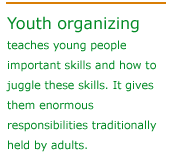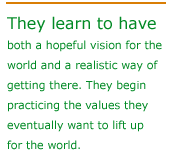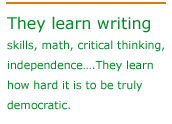|
Kim previously lived and worked in the South Bronx. There she
was one of 13 founding members of Youth Force, a youth-led project
that established the South Bronx Community Justice Center. Its initiatives
included supporting youth in juvenile detention to fight for better
conditions; Teens and Tenants (TNT), youth-led tenant organizing
to rehabilitate and protect low-income housing; Street University,
which connects youth involved in street level drug trafficking to
jobs, education, housing and other resources; and Politrix, which
enables youth to affect the design and implementation of public
policy, city and state budgets, as well as to register and educate
youth voters.
In 1998 Kim was a community fellow with the Open Society Institute
and in 1999 received a Union Square Award from the The Fund for
the City of New York. As with many other organizers working with
young people, Kim’s commitment to the work comes from struggles
she faced as as a young person, including experiences with the juvenile
justice system, inferior schooling, family and community violence,
and teen pregnancy.
Kim spoke with What Kids Can Do in May 2003.
Why youth organizing?
I think that for many people our commitment to youth organizing
is because of both the personal and community transformation it
brings.
For example, the skills youth (and adults) get from organizing
are endless. In large part, this is because organizing engages youth in a process
that builds toward community, institutional and/or policy change.
So, for example, you could have a group of young people create their
own play about racial inequity in the school system, perform it
at a school assembly, and then engage in consciousness raising discussions
with other students afterwards. This is all good, but standing alone,
it’s not youth organizing. You could have young people do research
on, say, environmental toxins in their community and present their
findings in a written report to public officials or the media—
but again by itself, this isn’t youth organizing. You could
have young people spend a day lobbying at the state Capitol about
cuts in education or youth programs. Still, this alone isn’t
youth organizing. It's when you put all of these elements together
that youth are engaged in organizing.
Youth organizing teaches young people not only a large set of
very important skills, but also how to juggle these skills. It gives
them enormous responsibilities traditionally held by adults.
And youth organizing also enables young people to gather these
skills together, in a way that's immediately relevant to people's
lives, and that gives it special strength. So, for example, most
schools know that youth are frequently stopped and searched by police,
or that they pass brownfields and abandoned lots on the way to class.
Teachers witness the hate crimes and harassment that happens on
school campuses, or the too frequent tracking of white youth into
college prep and youth of color into vocational ed. But, almost
always, students are asked to put all that aside and concentrate
on traditional studies. Occasionally a discussion comes up, but
it rarely includes a call to action, let alone the design and implementation
of actual solutions. Most of the time the lesson is to study hard
so you can get up and out of the community, and schools reward themselves
on graduating the occasional honor student. This is at the core
of why so many students feel education is meaningless! It's also
why so many youth who drop out of traditional educational settings
excel at organizing.
What makes a campaign successful?
A successful organizing campaign has a number of steps:
[1] It starts with identifying your constituency: Who do
you feel you represent? Youth (like adults) are most successful
when they represent the community they are organizing.
[2] Youth then conduct a strength and needs assessment:
identifying constituents' needs, skills, resources, and vision for
change. At this stage, youth are often engaged in developing, conducting,
transcribing and assessing surveys, interviews and personal stories.
You learn to avoid bias in the development of questionnaires and
interview techniques, as well the importance of both valuing others'
experiences and opinions and selecting a representative sample of
people to reach out to.
[3] Next, youth scan existing research — in relation
to concerns or issues identified in the community research. This
includes collecting demographic data, GIS mapping [Geographic Information
Systems], assessing research conducted by others. Often research
also requires investigating primary sources, something few schools
teach or expect from students. For example, when young people in
Los Angeles decided to challenge the high incarceration of youth—one
of the highest rates in the country—the first question they
needed to explore was why it was so high here. To answer the question,
they had to go back to the 1600s and search a wide variety of sources
in order to build a chronology of law enforcement policies and practices
over 400 years.
It's here that youth also begin to experience democracy in action.
Organizing is one of the few fields that depends on hearing from
many people and reaching a consensus about the future that people
want as well as the best way to get there.
[5] Base-building is the fifth step, and youth designing
and leading democratic processes really takes off here. Youth are
engaged in determining what sort of organizational structure will
best serve their social justice goals, including often incorporating
as a nonprofit organization—and then actually filing the required
legal papers. It means creating and implementing a membership
recruitment and communications strategy, facilitating meetings,
developing curriculum, recording and communicating decisions, even
debating whether decisions will be made by majority rule or through
consensus.
[6] Next, youth need to create a political education strategy
that reaches both the core members of the campaign and a wider constituency.
They need to identify the sorts of questions that get others thinking,
questions like “What’s missing from the U.S. history you
learn in school? Who's profiled by police, who's locked up? Why
do some schools have science centers while others lack the money
for new books and basic supplies? Why are some communities targeted
by military recruiters and not others? Through political education,
youth help others to become critical in linking community conditions
to larger issues of race, gender, income, and immigration.
As you can see, the youth involved in this work are already engaged
as researchers, teachers, journalists, and policy makers. [7] Having researched the problems, identified the issues,
sketched out demands, and begun to educate the larger community,
youth now develop the campaign's power analysis, including researching
campaign targets. Who is the person (or small group) that has the
power to give you what you want? What do they believe? How have
they voted in the past? From where do they gain their strength —
financial resources, advice, support? Where are they vulnerable?
Who are their allies, and yours — and who can you move? The
answers to these questions, combined with the other analyses you’ve
already done, should produce a short-term strategy, a long-term
vision, and a final list of demands—all of which you’ll
use to measure your success.
[8] Youth then develop their campaign action plan —
including beginning to select tactics that will most effectively
impact targets. In order to reach these decisions, youth must engage
in full debate, including the pros and cons of everything from traditional
advocacy to civil disobedience to violent confrontation. They learn
to have both a hopeful vision for the world and a realistic way
of getting there. And they come to terms with ethical questions
that many adults never confront, including how to begin practicing
the values you eventually want to lift up for the world.
[9] Youth must also build strong communications and media
skills. The details, responsibilities, and opportunities are enormous:
organizing community forums and school assemblies, educating residents
door-to-door, writing one’s own stories or creating one’s
own media (such as newsletters, CDs and videos), educating and cooperating
with journalists, organizing meetings with city officials, testifying
at public hearings, integrating cultural expression into outreach
(open mics, spoken word, graf and slap tags, etc.)
And all the time, you are re-evaluating your plan, noting your
progress, making adjustments.
Even the rallies and marches that inspire many campaigns involve
lots of duties: deciding when, where, and why to rally; getting
speakers and helping them to develop effective messages; setting
up a sound system; getting permits from police, sanitation, the
parks department; handling security and negotiating with police;
training people as marshals, coordinating legal support if there’s
a chance of arrests; coming up with chants and posters.
What else do young people get from
organizing?
They learn writing skills. In fact, they’re writing all the
time: producing research reports, newsletters, websites, curricula,
petitions, education guides, scripts for popular education skits,
grant proposals, speeches, dialogue for videos. And because they’re
writing for a public audience, they are more concerned about getting
it right; they are learning about the power of words well expressed.
They learn math. They produce budgets, order supplies, fill vouchers,
make requisitions, create estimates, buy insurance, enter data,
crunch numbers, prepare for audits.
They practice critical thinking, learning to ask hard questions,
make connections, gather evidence.
They learn tolerance for others while discovering and coming to
appreciate their own identity. They struggle with the oppression
that they have suffered as well as the hurt that they have caused
others, and gain the understanding that their own liberation is
dependent on the liberation of all other people.
Through organizing, youth quickly find that they are accountable
to a much larger community of people. They are visible, and they
push themselves to be both more responsible and caring as members
of families, groups, or communities. They learn about consensus
and teambuilding, about putting group interests before their own
interests. They learn how to be un-American, how to raise the collective
rather than strive for individual progress.
They also gain an understanding, connection and respect for a
world community, including how their local work challenges the concept
of national, ethnic, and religious borders that divide and separate.
They learn decision-making skills and get a chance to try out
and observe decision making in all sorts of settings, from City
Hall to organizing meetings with other youth. They see the inadequacy
of many decision-making models in the face of power inequities and
heated conflict. They learn how hard it is to be truly democratic.
And they often learn how to make decisions in crisis situations,
a skill their own lives will summon more than once.
Organizing gives young people a place to express and celebrate
youth culture, where, for example, hip hop and graffiti can find
full expression and earn respect. This is particularly crucial for
generations coming up after the 1960s, where much of our political,
racial, and community identity has been developed through hip hop.
Youth organizing gives young people specific opportunities to
pass on their learning to other youth. Youth who've been to Family
Court and fought to be reunited with a parent, to get custody of
their younger bothers and sisters, or to push for a particular placement
have then helped other youth negotiate the same process. Youth organizers
across the country are regularly teaching other young people (as
well as adults) how to deal with everything from securing welfare
and other entitlements to school suspension hearings, police stops,
and access to college prep.
Youth organizing offers so-called outsiders a place to build community
and fight for justice. For youth who’ve been pushed
out of institutions and opportunities, organizing rewards the very
skills that others criticize — speaking out, questioning rules,
expressing anger, challenging authority.
Through their activism, youth travel to parts of the city, the
state, the nation, and occasionally the world that they otherwise
would not see. It's not uncommon for organizing to take youth out
of their neighborhood or city, or on a plane or a train for the
first time. Even in their own neighborhood, organizing work can
lead youth to talk to strangers living a doorstep away.
Youth learn independence. In fact, youth organizing builds and
then relies on the capacity of young people to be independent.
Why is this work so compelling for many young people, especially
those who feel so frustrated and disrespected by traditional schools,
programs and institutions? Youth organizing overrides the false
adolescence we’ve created, where youth are ready to do important
work but are given few opportunities to actually do it. Youth organizing
respects that youth will lead with adults or without them,
and supports youth who want to speak out, challenge injustice, critique
and shape the world around them.
Finally, many of the youth that become involved in organizing
aren’t just leaders, but local heroes. Few other youth development
activities offer young people the chance, for example, to help rid
their community of a toxic waste site or a corrupt police chief.
What better way for youth to overcome the isolation and anger they
feel in communities where too many people clutch their bags and
cross the street to avoid you!
See also:
|
 Kim McGillicuddy is an Organizer with Youth Justice Coalition/Free
LA, established in March 2002 by young people and youth organizations
dealing first-hand with what they describe as California's “undeclared
war on youth” — embodied in state legislation that increases
the criminalization of vulnerable youth in a state that already sets
records for youth incarceration. The Coalition is led by youth ages
8 to 24 who have been arrested, detained, incarcerated, on probation,
or on parole.
Kim McGillicuddy is an Organizer with Youth Justice Coalition/Free
LA, established in March 2002 by young people and youth organizations
dealing first-hand with what they describe as California's “undeclared
war on youth” — embodied in state legislation that increases
the criminalization of vulnerable youth in a state that already sets
records for youth incarceration. The Coalition is led by youth ages
8 to 24 who have been arrested, detained, incarcerated, on probation,
or on parole.

 [4] Youth must then analyze the data surfaced from the research
activities—looking at everything you’ve found and bringing
the results back to your youth constituency for discussion. Through
these discussions you decide together whether you want to act on
these concerns. If so, then you begin identifying the specific issues
you’ll take on and determining your short and long-term organizing
goals. These goals are often worded as a youth platform or campaign
demands.
[4] Youth must then analyze the data surfaced from the research
activities—looking at everything you’ve found and bringing
the results back to your youth constituency for discussion. Through
these discussions you decide together whether you want to act on
these concerns. If so, then you begin identifying the specific issues
you’ll take on and determining your short and long-term organizing
goals. These goals are often worded as a youth platform or campaign
demands.

 They gain a view of history from the bottom up, and are connected
to both the lessons and countless actors of past and present movements
in the U.S. and worldwide. Where most youth might get a paragraph
on John Brown or Martin Luther King in a high school civics class,
organizing gives people much more of the conflict, context, tools,
and tactics that make history real. And because they are introduced
to the actions of the masses rather than only the rhetoric of the
powerful, youth can also begin to see themselves as history-makers.
They gain a view of history from the bottom up, and are connected
to both the lessons and countless actors of past and present movements
in the U.S. and worldwide. Where most youth might get a paragraph
on John Brown or Martin Luther King in a high school civics class,
organizing gives people much more of the conflict, context, tools,
and tactics that make history real. And because they are introduced
to the actions of the masses rather than only the rhetoric of the
powerful, youth can also begin to see themselves as history-makers.
